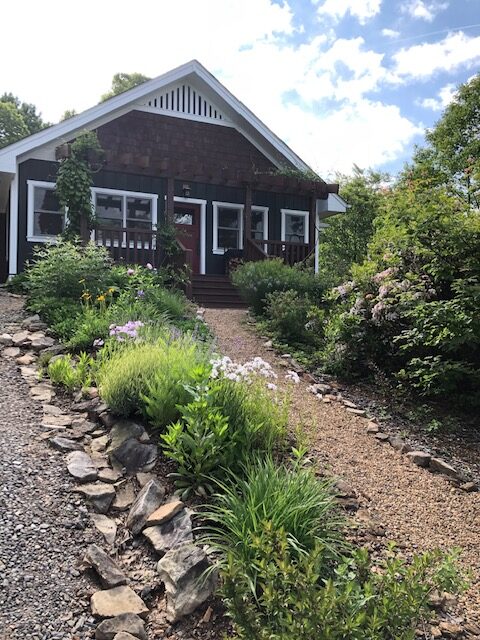By Debbie Green
When you go on native plant hikes throughout the year, do the beautiful spring ephemerals, flowering shrubs and trees, and their colorful fall foliage inspire you to use native plants in your own yard? When I moved to western North Carolina from Williamsburg, Virginia, in 2005 I was amazed by the abundance of native plants! I resolved to include many in my new home garden.
Garden Beginnings
I was a life-long gardener when I built my small home on a .66-acre wooded lot near Black Mountain, NC. Even if you don’t consider yourself a gardener, native plants can be one of the easiest and least expensive ways to create a beautiful landscape. I know because by the time I built my house I had little money left for landscaping!
The first rule for successful gardening, no matter where you’re planting, is to choose the “right plant for the right place.” You need to know something about your planting area: How sunny or shady? How moist or dry? Is the soil poor or rich? How about soil pH, is it acid or alkaline?
When landscaping with native plants, understanding how plants grow in communities is also helpful. In North Carolina, our coastal, piedmont, and mountain regions are each home to distinctive native plant communities. The North Carolina Natural Heritage Program has an ongoing project to identify these communities: Natural Heritage publications
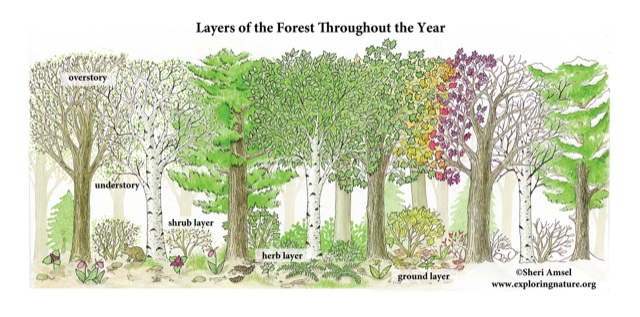
My woodland lot, with its most mature trees at least 70 years old, clearly fit the Montane Oak–Hickory Forest (Acidic Subtype) https://www.ncnhp.org/media/125/open Although this forest community has poor, acid soil that is mostly dry, it still supports an amazing variety of plants.
Working with Forest Succession
Most homesites in North Carolina, if left alone, undergo forest succession, and eventually have a ground layer, an herbaceous layer, shrubs, understory trees and a tree canopy. Cultivated gardens may mimic these layers, but gardeners often try to maintain some static ideal. I realized that gardening with native plants is a great way to work with succession to create, as Travis Beck says in his book Principles of Ecological Landscape Design, “a series of visions that reveal themselves over time” (p. 198).
Because I asked the builder to leave as much of my lot as undisturbed as possible, I started with the canopy tree species, the understory trees, shrubs, and herbaceous layers intact on much of the property. In wetter years I began to see more of a ground layer—particularly mosses—than I saw in the drier years when I first started my landscaping.
No matter when or where you start with your native plant landscaping, creating multilayered plantings— Ground, Herbaceous, Shrub, Understory, Canopy—is a useful framework for designing and maintaining your garden.
Caveats
Translating forest layers into home landscaping benefits from using planting patterns that differ from Mother Nature’s. For example, you may want more diversity in your landscape, or you may want to plant more densely than you’d see in a forest. This was certainly true for me, especially in the areas right around my house and the sunny areas on some edges (where the property abuts others’ lots and the road).
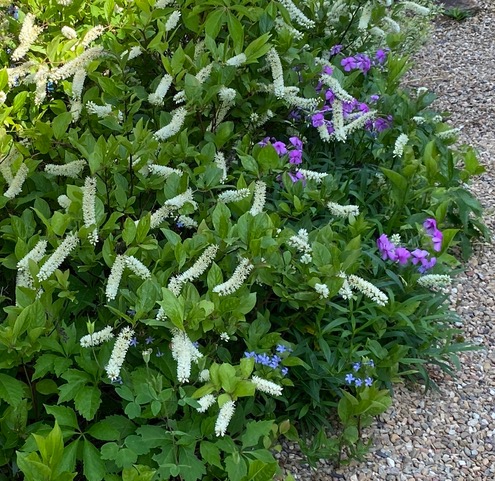
When you consider gardening with natives, the main obstacles are ones that people create. The first is the fact that many homesites are in areas too urban or disturbed by construction to resemble native conditions. The second is that many conventional gardening goals or community restrictions—often set by Homeowners’ Associations—view native plant landscaping as too informal, too messy, or somehow not interesting enough!
Although my property was relatively undisturbed, building the house inevitably altered some of the lot and created both challenges and opportunities for including a variety of plantings. Although I am not a member of a Homeowners Association, almost all the homes on my street are part of a small HOA. Shortly after I moved in, my across-the-street neighbors told me that they didn’t understand why the builder hadn’t removed all the native vegetation in front of my new house and they would be happy to pay to take it out!
If you are concerned about making your landscape look conventional, using color, pruning, framing (or defining planting areas), and using containers are all ways to make your native plants fit into a more traditional garden.
Where Do the Plants Come From?
I was lucky to build in an existing plant community. In addition to the plants I preserved during construction, I watched every new plant that emerged and worked hard to identify it. One resource I found useful for plants not found in gardening centers was Forest Plants of the Southeast and Their Wildlife Uses by James H. Miller and Karl V. Miller (University of Georgia Press, 2005). My early gardening years were mostly an editing process: keep the natives and eliminate any undesirables.
Many existing and emerging plants were desirable—and sometimes unusual—natives, not only herbaceous annuals and perennials, but shrub and tree seedlings, as well. In addition to Mountain Laurel (Kalmia latifolia) and many Vaccinium species, including Deerberry (V. stamineum), the shrub layer included Tall Indigo-bush (Amorpha fruticosa) and New Jersey Tea (Ceanothus americanus). The herbaceous layer tends to be sparse in this community, but on my property some of the gems I treasure are Eastern Flowering Spurge (Euphorbia corollata), Hairy Angelica (Angelica venenosa), and the many goldenrods (Solidago species) that have appeared in sunny areas.
You, too, likely have a seedbank of natives in your soil, and “volunteers” brought in by wind or gravity. If not, you can purchase plants or seeds of appropriate species to create your landscape. If possible, purchase ecotypes—plants adapted to your locality—and consider if the straight species may provide more support to local wildlife than “nativars.” There is an ever-increasing body of information about which cultivars of native plants retain the plant characteristics that are attractive to pollinators, for example.
Creating Four Season Interest
One of the advantages of living in North Carolina is that most of us can have gardens that shine in all four seasons. Native evergreen trees, shrubs, and ground layers provide four season continuity in your landscape, while deciduous woodies and the herbaceous layer provide the seasonal shifts.
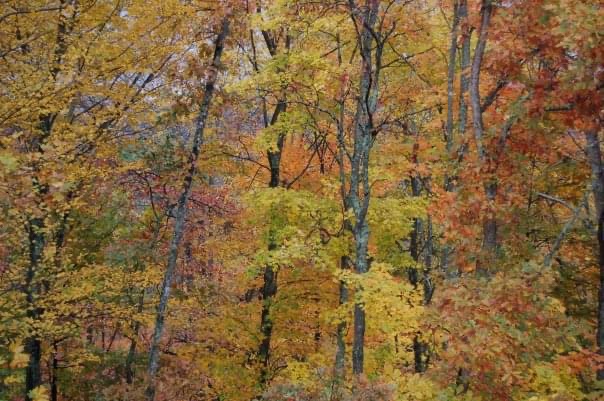
Deciduous trees and shrubs in spring have buds and flowers, in summer leaves and fruits, in autumn leaf color changes and seed pods, and in winter show off their bark and branch structure. In the herbaceous layer, you’ll have all the spring ephemerals, then summer and fall-blooming flowers. In winter many of these flowering plants have persistent seed or flower heads.
As I developed my landscape, I filled some disturbed areas with only native plants, but chose ones that fit the altered conditions rather than the ones typically found in the original plant community. In other areas I included some of my traditional garden favorites intermixed with natives.
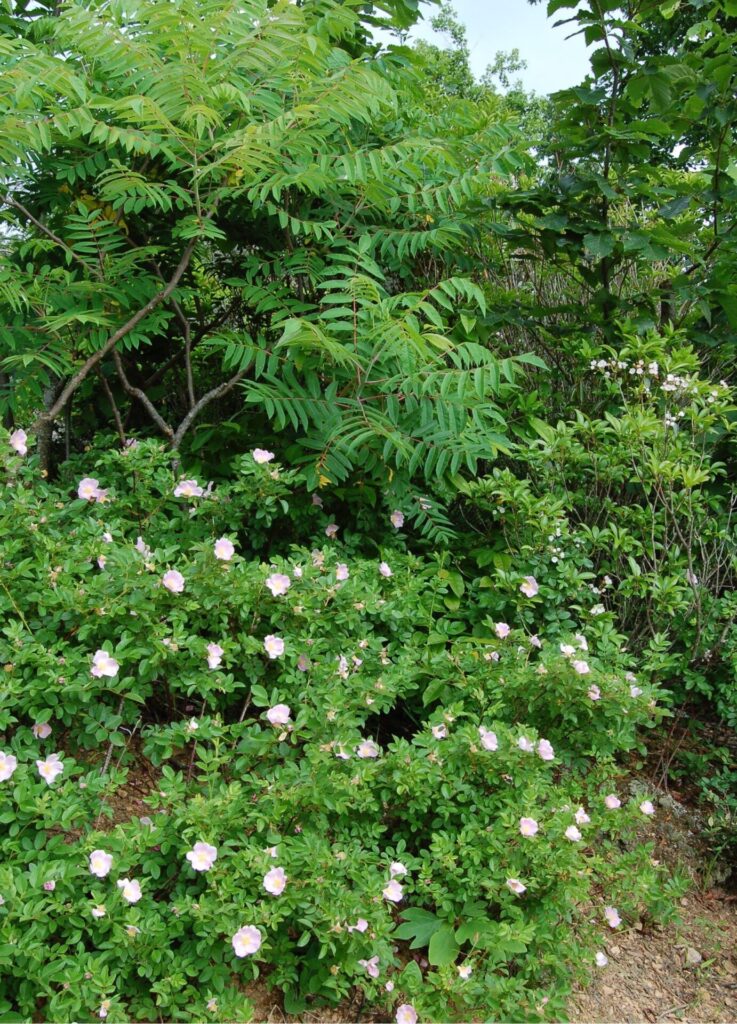
I was fortunate that my lot was not overrun with exotic invasives, although I do battle Oriental Bittersweet (Celastrus orbiculatus), Japanese Stiltgrass (Microstegium vimineum) and the occasional Burning Bush (Euonymus alata)! Removing invasive species is important because they can quickly overwhelm views and they will aggressively replace native plants in some layers.
After fifteen years in my garden, the natives are thriving, I’ve seen succession reveal many new visions, and I’m still learning something new every season!
By Debbie Green
Native Plant News – Summer 2022

Debbie Green is a longtime member of the North Carolina Native Plant Society and a Buncombe County Extension Master Gardener Volunteer. Before moving to North Carolina she retired as Professor Emerita from the Psychology Department of the College of William and Mary. She enjoys gardening and traveling–often to gardens–with her partner of five years, Bob Wardwell.
